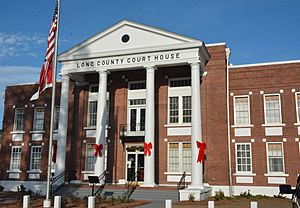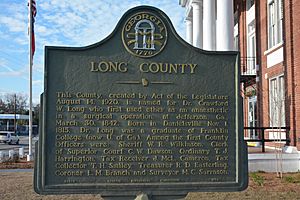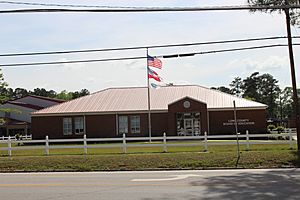Long County, Georgia facts for kids
Quick facts for kids
Long County
|
|
|---|---|

Long County Courthouse in Ludowici
|
|

Location within the U.S. state of Georgia
|
|
 Georgia's location within the U.S. |
|
| Country | |
| State | |
| Founded | November 2, 1920 |
| Seat | Ludowici |
| Largest city | Ludowici |
| Area | |
| • Total | 404 sq mi (1,050 km2) |
| • Land | 400 sq mi (1,000 km2) |
| • Water | 3.5 sq mi (9 km2) 0.9%% |
| Population
(2020)
|
|
| • Total | 16,168 |
| • Density | 40/sq mi (20/km2) |
| Time zone | UTC−5 (Eastern) |
| • Summer (DST) | UTC−4 (EDT) |
| Congressional district | 1st |
Long County is a county located in the U.S. state of Georgia. The county seat is Ludowici. Long County is part of the Hinesville-Fort Stewart Metropolitan Statistical Area. The constitutional amendment to create the county was proposed August 14, 1920, and ratified November 2, 1920. The county is named after Crawford Long (1815–1878), an American surgeon and pharmacist who was the first to use diethyl ether as an anaesthetic.
As of the 2020 census, the population was 16,168.
Contents
Geography
According to the U.S. Census Bureau, the county has a total area of 404 square miles (1,050 km2), of which 400 square miles (1,000 km2) is land and 3.5 square miles (9.1 km2) (0.9%) is water.
The majority of Long County, roughly centered on Ludowici, is located in the Altamaha River sub-basin of the basin by the same name. The county's northeastern portion, east of Glennville and northwest of Walthourville, is located in the Canoochee River sub-basin of the Ogeechee River basin. Long County's southeastern portion is located in the Ogeechee Coastal sub-basin of the larger Ogeechee basin.
Major highways
Adjacent counties
- Liberty County (northeast)
- McIntosh County (southeast)
- Wayne County (southwest)
- Tattnall County (northwest)
Communities
City
- Ludowici (county seat)
- Elim, Georgia
Unincorporated communities
- Aimar
- Beards Creek
- Donald
- Tibet
Demographics
| Historical population | |||
|---|---|---|---|
| Census | Pop. | %± | |
| 1930 | 4,180 | — | |
| 1940 | 4,086 | −2.2% | |
| 1950 | 3,598 | −11.9% | |
| 1960 | 3,874 | 7.7% | |
| 1970 | 3,746 | −3.3% | |
| 1980 | 4,524 | 20.8% | |
| 1990 | 6,202 | 37.1% | |
| 2000 | 10,304 | 66.1% | |
| 2010 | 14,464 | 40.4% | |
| 2020 | 16,168 | 11.8% | |
| 2023 (est.) | 19,594 | 35.5% | |
| U.S. Decennial Census 1790-1880 1890-1910 1920-1930 1930-1940 1940-1950 1960-1980 1980-2000 2010 |
|||
| Race | Num. | Perc. |
|---|---|---|
| White (non-Hispanic) | 8,774 | 54.27% |
| Black or African American (non-Hispanic) | 4,028 | 24.91% |
| Native American | 62 | 0.38% |
| Asian | 164 | 1.01% |
| Pacific Islander | 88 | 0.54% |
| Other/Mixed | 1,073 | 6.64% |
| Hispanic or Latino | 1,979 | 12.24% |
As of the 2020 United States census, there were 16,168 people, 5,695 households, and 4,146 families residing in the county.
Education
Long County School System operates public schools for grades K-12 in the county, except parts in Fort Stewart. Fort Stewart has the Department of Defense Education Activity (DoDEA) as its local school district, for the elementary level. Students at the secondary level on Fort Stewart attend public schools operated by county school districts.
See also
 In Spanish: Condado de Long (Georgia) para niños
In Spanish: Condado de Long (Georgia) para niños



